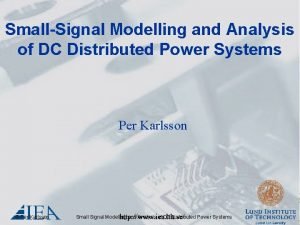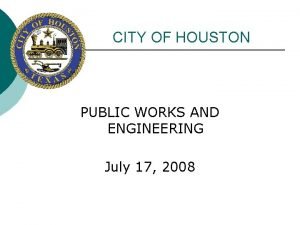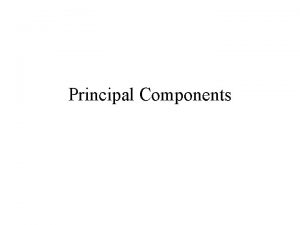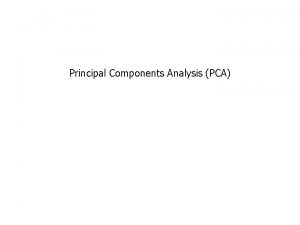Principal Components ShyhKang Jeng Department of Electrical Engineering





























































- Slides: 61

Principal Components Shyh-Kang Jeng Department of Electrical Engineering/ Graduate Institute of Communication/ Graduate Institute of Networking and Multimedia 1

Concept of Principal Components x 2 x 1 2

Principal Component Analysis Explain the variance-covariance structure of a set of variables through a few linear combinations of these variables Objectives – Data reduction – Interpretation Does not need normality assumption in general 3

Principal Components 4

Result 8. 1 5

Proof of Result 8. 1 6

Result 8. 2 7

Proof of Result 8. 2 8

Proportion of Total Variance due to the kth Principal Component 9

Result 8. 3 10

Proof of Result 8. 3 11

Example 8. 1 12

Example 8. 1 13

Example 8. 1 14

Geometrical Interpretation 15

Geometric Interpretation 16

Standardized Variables 17

Result 8. 4 18

Proportion of Total Variance due to the kth Principal Component 19

Example 8. 2 20

Example 8. 2 21

Principal Components for Diagonal Covariance Matrix 22

Principal Components for a Special Covariance Matrix 23

Principal Components for a Special Covariance Matrix 24

Sample Principal Components 25

Sample Principal Components 26

Example 8. 3 27

Example 8. 3 28

Scree Plot to Determine Number of Principal Components 29

Example 8. 4: Pained Turtles 30

Example 8. 4 31

Example 8. 4: Scree Plot 32

Example 8. 4: Principal Component One dominant principal component – Explains 96% of the total variance Interpretation 33

Geometric Interpretation 34

Standardized Variables 35

Principal Components 36

Proportion of Total Variance due to the kth Principal Component 37

Example 8. 5: Stocks Data Weekly rates of return for five stocks – X 1: – X 2: – X 3: – X 4: – X 5: Allied Chemical du Pont Union Carbide Exxon Texaco 38

Example 8. 5 39

Example 8. 5 40

Example 8. 6 Body weight (in grams) for n=150 female mice were obtained after the birth of their first 4 litters 41

Example 8. 6 42

Comment An unusually small value for the last eigenvalue from either the sample covariance or correlation matrix can indicate an unnoticed linear dependency of the data set One or more of the variables is redundant and should be deleted Example: x 4 = x 1 + x 2 + x 3 43

Check Normality and Suspect Observations Construct scatter diagram for pairs of the first few principal components Make Q-Q plots from the sample values generated by each principal component Construct scatter diagram and Q-Q plots for the last few principal components 44

Example 8. 7: Turtle Data 45

Example 8. 7 46

Large Sample Distribution for Eigenvalues and Eigenvectors 47

Confidence Interval for li 48

Approximate Distribution of Estimated Eigenvectors 49

Example 8. 8 50

Testing for Equal Correlation 51

Example 8. 9 52

Monitoring Stable Process: Part 1 53

Example 8. 10 Police Department Data *First two sample cmponents explain 82% of the total variance 54

Example 8. 10: Principal Components 55

Example 8. 10: 95% Control Ellipse 56

Monitoring Stable Process: Part 2 57

Example 8. 11 T 2 Chart for Unexplained Data 58

Example 8. 12 Control Ellipse for Future Values *Example 8. 10 data after dropping out-of-control case 59

Example 8. 12 99% Prediction Ellipse 60

Avoiding Computation with Small Eigenvalues 61
 Electrical engineering department
Electrical engineering department Tum
Tum Ucla electrical engineering
Ucla electrical engineering Aircraft electrical system components
Aircraft electrical system components Frc electrical components
Frc electrical components Vector electrical engineering
Vector electrical engineering George washington university electrical engineering
George washington university electrical engineering Tel aviv university electrical engineering
Tel aviv university electrical engineering Electrical engineering northwestern
Electrical engineering northwestern Klipsch school of electrical and computer engineering
Klipsch school of electrical and computer engineering Umd electrical engineering
Umd electrical engineering Electrical wiring estimating and costing
Electrical wiring estimating and costing Electrical engineering environmental issues
Electrical engineering environmental issues Ece flow chart wpi
Ece flow chart wpi Electrical engineering presentation
Electrical engineering presentation Kfupm ee faculty
Kfupm ee faculty Big data in electrical engineering
Big data in electrical engineering Define electrical engineering
Define electrical engineering Basic electrical engineering kulshreshtha
Basic electrical engineering kulshreshtha University of belgrade school of electrical engineering
University of belgrade school of electrical engineering Electrical engineering notation
Electrical engineering notation Bus electrical engineering
Bus electrical engineering The world says hello
The world says hello Ece clemson
Ece clemson Usf canvas
Usf canvas Phasors electrical engineering
Phasors electrical engineering Electrical engineering technion
Electrical engineering technion Lina lehn
Lina lehn Rensselaer polytechnic institute electrical engineering
Rensselaer polytechnic institute electrical engineering 고유응답
고유응답 Newton raphson method electrical engineering
Newton raphson method electrical engineering Louisiana tech electrical engineering
Louisiana tech electrical engineering Faculty of electrical engineering
Faculty of electrical engineering Engineering ethics
Engineering ethics Electrical engineering fundamentals 66712 pdf
Electrical engineering fundamentals 66712 pdf Uh electrical engineering flowchart
Uh electrical engineering flowchart Electrical engineering roadmap
Electrical engineering roadmap Tel aviv university electrical engineering
Tel aviv university electrical engineering Oscilloscope theory
Oscilloscope theory Emt subject in engineering
Emt subject in engineering Electrical engineering subdisciplines
Electrical engineering subdisciplines Electrical engineering
Electrical engineering Electrical engineering fundamentals 66712 pdf
Electrical engineering fundamentals 66712 pdf Berkeley
Berkeley Electrical engineering
Electrical engineering Electrical engineering
Electrical engineering Electrical engineering math
Electrical engineering math Keɪɒs
Keɪɒs Asu online ee
Asu online ee Principles and applications of electrical engineering
Principles and applications of electrical engineering Newton raphson method electrical engineering
Newton raphson method electrical engineering Electrical engineering
Electrical engineering Fau computer engineering flowchart
Fau computer engineering flowchart Principles and applications of electrical engineering
Principles and applications of electrical engineering Spletna učilnica fe
Spletna učilnica fe George washington university electrical engineering
George washington university electrical engineering Deguration
Deguration Engineering department in a hotel
Engineering department in a hotel City of houston engineering department
City of houston engineering department Engineering key performance indicators
Engineering key performance indicators Department of information engineering university of padova
Department of information engineering university of padova Information engineering padova
Information engineering padova





















































































